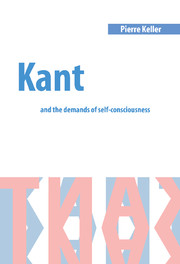Book contents
- Frontmatter
- Contents
- Acknowledgments
- 1 Introduction
- 2 Introducing apperception
- 3 Concepts, laws, and the recognition of objects
- 4 Self-consciousness and the demands of judgment in the B-Deduction
- 5 Self-consciousness and the unity of intuition: completing the B-Deduction
- 6 Time-consciousness in the Analogies
- 7 Causal laws
- 8 Self-consciousness and the pseudo-discipline of transcendental psychology
- 9 How independent is the self from its body?
- 10 The argument against idealism
- 11 Empirical realism and transcendental idealism
- Conclusion
- Notes
- Bibliography
- Index
5 - Self-consciousness and the unity of intuition: completing the B-Deduction
Published online by Cambridge University Press: 22 September 2009
- Frontmatter
- Contents
- Acknowledgments
- 1 Introduction
- 2 Introducing apperception
- 3 Concepts, laws, and the recognition of objects
- 4 Self-consciousness and the demands of judgment in the B-Deduction
- 5 Self-consciousness and the unity of intuition: completing the B-Deduction
- 6 Time-consciousness in the Analogies
- 7 Causal laws
- 8 Self-consciousness and the pseudo-discipline of transcendental psychology
- 9 How independent is the self from its body?
- 10 The argument against idealism
- 11 Empirical realism and transcendental idealism
- Conclusion
- Notes
- Bibliography
- Index
Summary
Kant develops and supports the claim to objectivity implicit in judgment by first arguing that all judgment that is dependent on a specific subject-matter dependent judgment derives its content from spatio-temporal experience and then by arguing that we can represent all objects in space and time together in a manner that is standpoint-neutral. This standpoint-neutral manner of representing objects in space and time is due to their relation to a possible self-consciousness. As contents of consciousness, objects in space and time are representable in a manner that depends on the spatio-temporal standpoint of the observing consciousness. However, this standpoint-dependent perspective is itself only intelligible relative to a possible standpoint-independent perspective from which the standpoint of the observer becomes cognitively accessible.
By appealing to the standpoint-neutral constraints on representing standpoint-dependent truths, it is possible to justify the objectivity claim made by judgment. Objectivity then consists in the way things must be represented in space and time so that they are the same for all observers at all spatio-temporal locations. Kant seeks to make it comprehensible how even subjective experiences can be regarded as subject to objectivity constraints. The key thesis here is that subjective experiences are inherently dependent on the way things present themselves to the spatio-temporal point of view of some consciousness. But this particular point of view is only intelligible as a specific perspective that one can take as a self.
Information
- Type
- Chapter
- Information
- Kant and the Demands of Self-Consciousness , pp. 87 - 112Publisher: Cambridge University PressPrint publication year: 1999
